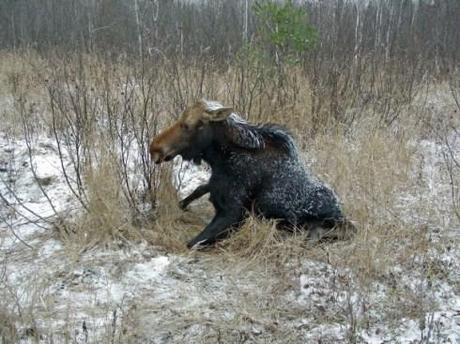by Darryl Fears / Washington Post

Tens of millions of winter ticks are preparing to hatch next month from eggs hidden in thick brush. They will wait there to hitch a ride on a moose and suck its blood until the end of May.
They can send a moose to its death, with up to 150,000 dining on every calf, cow and bull in certain parts of the Granite State, wildlife biologists estimate.
There was a time when eggs laid in this age-old cycle perished on winter snow. But that hasn’t happened lately in New Hampshire, where a warming trend has winters starting later and ending sooner.A single female lays 3,000 eggs the size of salt crystals. With warmer weather, ticks don’t die, they multiply.
Winter ticks are one-host parasites that feed on a single animal through their lifetimes. As the number of ticks explodes, moose have disappeared by the thousands in areas where they were most abundant. Many of those still alive are eerily thin, with rib cages visible through ragged skin. They are mere shadows of themselves, zombies with antlers.
“It’s pretty depressing,” said Kristine Rines, a wildlife biologist and moose project leader for the state’s Fish and Game Department. “It’s a pretty tough way to go. There’s no question that climate plays a huge part in this. If we had winters that lasted as long as they used to, we might not be having this conversation.”
New Hampshire’s struggle with moose is part of a nationwide trend, according to the Wildlife Management Institute, a nonprofit group established by sportsmen and businessmen concerned about wild populations.
A rise in moose die-offs has been reported in Minnesota, Montana, Wyoming, other parts of the Rocky Mountains and a sliver of North Dakota. In Montana, Minnesota and North Dakota, it’s not clear that ticks are the entire problem, leaving scientists baffled over why so many moose have fallen.
Only Maine, where colder winters and snow still kill ticks, is showing a population increase, with more than 75,000 in the state’s range.
Moose are more than oafish creatures that lumber across the wilderness. They are the largest of the deer species, with bulls that top 1,800 pounds and grow antlers six feet wide.
The impact of reduced moose populations reverberates through an ecosystem. Moose serve as walking lawn mowers, clearing brush and creating spaces for smaller species, such as rabbits and birds, to hide from predators. Moose also provide hearty meals for coyotes and bears; a single carcass can feed these animals for days.
But loaded with ticks, they scratch until their fur falls off. They develop anemia and starve, Rines said.
They eventually become so stressed from tens of thousands of tiny bites every minute and every day that they can’t eat even if food is handed to them. “They look terrible. Their body weights are down. They have secondary skin infections from multiple bites,” Rines said, and they lose so much fur that they freeze whenever the weather manages to turn cold.

